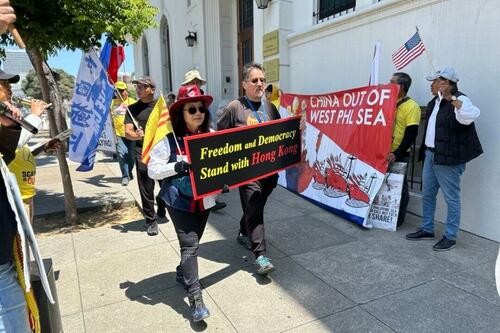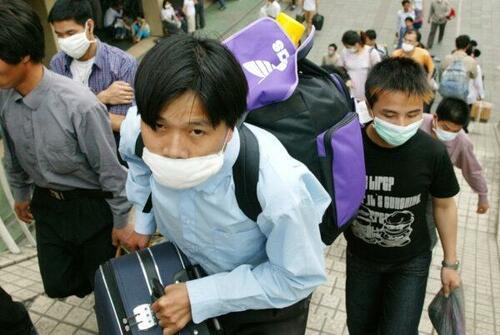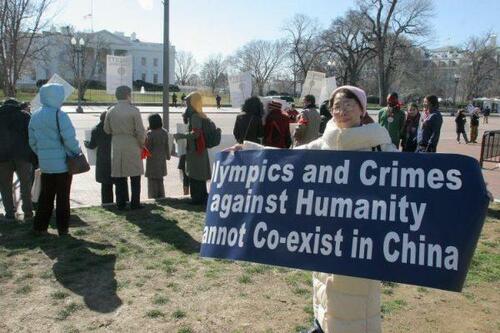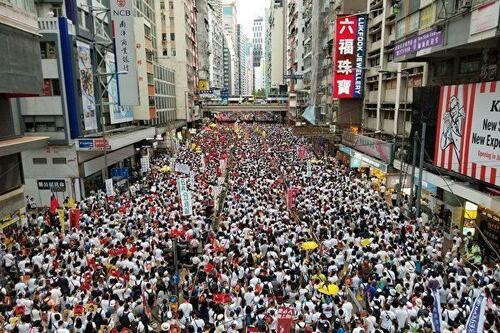Authored by Tamuz Itai via The Epoch Times,
For nearly three decades, the Western world has hardly had a calm time—terrorist attacks, wars in the Middle East and Ukraine, financial meltdowns, pandemics, and deepening political fractures. Each has seized the headlines, drained treasuries, and monopolized the attention of policymakers from Washington to Brussels.
The result? A fractured focus, where urgent fires crowd out long-term threats.
But when aligning these moments of Western disarray against Beijing’s calendar, a pattern emerges. For whatever reason, many of China’s most pivotal advances—territorial, economic, institutional—have landed precisely during, or just ahead of, the West’s moments of distraction.
A Chronicle of Overlaps
It begins in the summer of 1997, on July 2. Thailand devalues its baht, unleashing the Asian Financial Crisis—that would engulf markets from Seoul to Jakarta, wiping out trillions in value and exposing the fragility of emerging “Asian Tiger” economies. Markets convulsed, currencies plummeted, and lenders scrambled.
Yet on July 1—just one day prior—Britain handed Hong Kong back to Beijing after 156 years of colonial rule. At the very moment Asia’s financial markets crashed, China assumed sovereignty over one of the world’s premier financial hubs: a gateway to global capital that would soon fuel its export machine.
Fast-forward to May 1999 during NATO’s Kosovo campaign. On May 7, U.S. warplanes, in a tragic error, bombed the Chinese Embassy in Belgrade, killing three and wounding dozens. Fury erupts. Days of protests surge outside American missions in Beijing and beyond, a raw wound that would fester in U.S.–China relations for years.
It’s worth noting that in China, demonstrations of this scale are almost always state-managed. That embassy strike seems to have etched a scar, eroding trust at a moment when the West was consumed by the moral and military imperatives of intervention. In July 1999, the Chinese Communist Party (CCP) launched its persecution of the Falun Gong spiritual group, which continues to this day.
The turn of the millennium brought Sept. 11, 2001: Al-Qaeda’s hijackers struck the World Trade Center, claiming nearly 3,000 lives in the deadliest assault on U.S. soil. Washington, reeling, pivots to a global war on terror, reshaping alliances, budgets, and intelligence priorities.
Three months later that year, China formally joined the World Trade Organization (WTO), capping 15 years of negotiations and thrusting itself into the rules-based global economy, only to eventually flout most of them. While America mourned and mobilized, Beijing integrated, gaining access to markets that would fuel its manufacturing ascent.
By March 20, 2003, U.S.-led forces invaded Iraq, toppling Saddam Hussein in a campaign that would entangle the West for two decades. That same month, whispers of a new threat came from China: Severe Acute Respiratory Syndrome (SARS) began spreading internationally, prompting the WTO to issue its first global alert on March 12 for clusters of atypical pneumonia in Guangdong and Hanoi. As Washington’s bandwidth vanished into the sands of the Middle East, the first modern pandemic came from the East, with Beijing initially denying it and later clamping down on reporting its true scale—basically punishing officials who reported the numbers, an early warning.
Migrant workers wearing protective face masks make their way to the train station as they leave the city over worries about SARS in Guangzhou, the capital of Guangdong Province, China, on May 2, 2003. Christian Keenan/Getty Images
On July 7, 2005, suicide bombers shattered London’s transit system, killing 52 in a coordinated assault that, per the UK government’s inquiry, exposed gaping holes in counterterrorism readiness. Europe was alarmed, tightening borders and redoubling intelligence-sharing.
Meanwhile, Beijing, undeterred, accelerated its outbound investments through eased merger-and-acquisition rules and launched the inaugural U.S.–China Senior Dialogue in August that year—a forum for economic and security talks that would evolve into deeper bilateral ties. As Europe focused on anti-terrorism, China wove itself more tightly into Western financial webs.
August 2008 brought the Beijing Olympics, a dazzling showcase of China’s having “arrived.” By Sept. 15, Lehman Brothers’ collapse ignited the Global Financial Crisis, plunging the West into recession and prompting bailouts from Wall Street to London to Frankfurt. By November, Beijing unveiled a staggering $586 billion stimulus package—a lifeline that not only stabilized its own economy but propped up global commodity demand, from iron ore to oil. As Western banks teetered, China’s fiscal firepower accelerated its trajectory from factory floor to a creditor nation.
Protesters hold signs outside the White House during a demonstration organized by Amnesty International calling on China to respect human rights ahead of the 2008 Summer Olympic Games, in Washington on Feb. 11, 2008. Nicholas Kamm/AFP/Getty Images
Europe’s sovereign debt implosion followed in May 2010, with Greece’s first bailout exposing fissures in the eurozone. Beijing responded by ramping up overseas lending through state banks and, in September, imposing restrictions on rare-earth mineral exports. Massive investments and loans from Beijing began to buy European nations’ silence and acquiescence.
The early 2010s had multiple events: the Arab Spring protests of 2011 and 2012; Libya’s NATO-backed civil war; and persistent eurozone tremors. Western capitals juggled regime change, refugee flows, and austerity. In the shadows, Beijing methodically prepared its own transition of leadership: Xi Jinping’s elevation as heir apparent at the 2012 Party Congress, locking in a leadership transition primed for a more assertive posture. Global chaos provided the perfect cover for internal stealing and less scrutiny.
In March 2014, Russian President Vladimir Putin annexed Crimea, defying current international norms and drawing Western sanctions. Then, in October, 21 nations—including several U.S. allies—signed the memorandum to found the Asian Infrastructure Investment Bank (AIIB), Beijing’s rival to the World Bank. As the West isolated Moscow, China was building a parallel financial architecture.
In 2015, in Europe, ISIS’s rampage culminated on Nov. 13 in the Paris attacks, killing 130 in gunfire and bombs that sent the continent into mourning and heightened alerts. That summer, China’s stock market had already cratered, erasing trillions in value by July; Beijing responded with capital controls in August, throttling outflows to stem the bleed. The EU’s gaze was on the jihadists, while Beijing fortified its financial ramparts.
The Brexit vote on June 23, 2016, fractured the façade of the European project, ushering in years of negotiation and uncertainty. Mere weeks later, on July 12, the Permanent Court of Arbitration in The Hague ruled against the CCP’s expansive South China Sea claims, invalidating its “nine-dash line.” Beijing dismissed it outright, doubling down on island-building and patrols. The EU disarray mirrored—and perhaps muted—any unified Western rebuke.
By June 2019, Hong Kong’s streets ignited over an extradition bill, with mass protests that tested the CCP’s grip. This overlapped with escalating U.S. scrutiny: indictments against Huawei and its chief financial officer, Meng Wanzhou, unsealed in January but roiling through the year with arrest and extradition battles. Tech security emerged as the new fault line in great-power rivalry.
An "anti-extradition" parade with a million people packed the entire street in Hong Kong on June 9, 2019. Sung Pi-Lung/The Epoch Times
The pandemic arrived in late 2019, and in March 2020, the WHO declared COVID-19 a global emergency, with a reaction that overwhelmed hospitals and economies. Three months later, on June 30, Beijing imposed its National Security Law on Hong Kong, criminalizing dissent and drastically eroding the “one country, two systems” promise. Health crises drowned out major criticism.
August 2021 marked the United States’ exit from Afghanistan, which many have described as dismal, stranding allies and degrading U.S. credibility. Beijing wasted no time, hosting Taliban delegations in July and August to signal budding ties and position itself to fill the power vacuum in Central Asia.
On Feb. 24, 2022, Russia launched its full-scale invasion of Ukraine, leading to a protracted war of attrition. Just three weeks earlier, on Feb. 4, Xi and Putin had inked their “no-limits” partnership, a pact that would deepen military and economic bonds as missiles rained on Kyiv.
Hamas’s assault on Israel on Oct. 7, 2023, unleashed the Gaza war, polarizing allies and straining Western unity. Earlier that year, in March, Beijing had brokered a surprise détente between Iran and Saudi Arabia. As the West navigated the renewed focus on the Middle East, China hedged, courting all energy-rich states while supporting Hamas.
And now, in 2025, the cycle spins on. The Trump administration’s sweeping tariffs—up to 60 percent on Chinese imports—face mounting court challenges, including a U.S. Supreme Court review set for its September term following the Federal Circuit’s Aug. 29 strike-down of IEEPA-based duties. Beijing adapts by rerouting supply chains through new trade blocs and circumvention paths, as global commerce hardens into rival spheres—a new name for the much-denied decoupling.
Emerging Patterns
We can identify six tendencies when looking at the above ledger of corresponding events:
Distraction windows: China’s boldest strokes cluster amid Western crises, from territorial grabs to institutional launches.
Counter-cyclical advantage: When Western economies falter—think 2008 or 2010—Beijing expands, lending abroad or hoarding resources.
Institutional stress tests: As Wall Street wobbles or NATO strains, China erects alternatives, such as the AIIB, or defies rulings, such as those of The Hague.
Domestic consolidation: Global uproar muffles internal clampdowns, from Xi’s elevation to Hong Kong’s National Security Law.
Hedging and broker posture: In Gaza or Ukraine, Beijing plays the seemingly neutral broker, as with the Iran–Saudi Arabia deal.
A rhythm of 6 to 12 months: Moves happen within crisis windows, not dragging into years.
Sometimes, China acts just before the storm—the Olympics pre-Lehman, the Xi–Putin pact pre-Ukraine—and the distraction mutes retaliation. Did Beijing foresee these events, or worse? Perhaps. We have no proof either way. But the CCP’s ceaseless boundary-probing pays off when the West is otherwise occupied.
Addressing the Skeptics
To be clear, this pattern is far from flawless. But reality often is. For example, the Hong Kong handover was planned decades prior; the WTO accession was in the works for 15 years. Some moves, such as the 2008 stimulus, seemed to stem from China’s export problems. More generally, it is known that great powers act ceaselessly in many directions, so overlaps are inevitable.
However, so far, we’ve been pointing to a correlation, not a causation. The pattern does hold as a tendency. It is a signal, not noise. For whatever reasons, around the time distractions happen, Beijing pushes—and often prevails.
We can see that the War on Terror devoured trillions—$8 trillion on Iraq and Afghanistan alone, per Brown University’s Costs of War project—diverting the executive branch, Congress, and alliances’ energy from China strategy. The Obama administration’s 2011 “pivot to Asia” was under-resourced and hampered by ongoing Middle Eastern quagmires.
The same goes for internal drivers—for example, the Chinese 2008 stimulus. One might say that it was to salvage China’s export economy, not to exploit the Western crisis. However, those domestic imperatives do gain extra runway when rivals are suddenly sidelined.
When it comes to criticizing China’s conduct, even in the Iraq era, American diplomacy still hammered human rights violations and undervaluation. But try to imagine the alternative: undivided focus yielding sharper sanctions, faster alliances, and bolder industrial policies. Distraction didn’t completely erase a response—it greatly diluted it.
It is important to note here that the CCP is extremely sensitive about public human rights criticism. This could be a huge leverage point for the West, which sadly it rarely uses.
Interpretation and Implications
All of the above does indicate strategic timing: opportunism, at minimum. Distractions slash the price of audacity, whether post-facto or preemptive. It’s also a dual-track advance: outwardly, institutions such as AIIB court the Global South; inwardly, controls tighten from Xinjiang to Hong Kong. Gains are then baked in before resistance forms.
This pattern reveals as much about Western vulnerabilities as it does about Chinese strategy, and perhaps a lack of a bird’s-eye view of the true picture of geopolitics. Our responses have been either too little or too much—and decidedly too late—creating gaps for the CCP to fill.
As Mark Twain reputedly said, “History doesn’t repeat itself, but it often rhymes.” Here, the verse is unmistakable: When the West averts its gaze, China steps forward. It is up to us to be attuned to the rhyming and be ready to act.
Views expressed in this article are opinions of the author and do not necessarily reflect the views of The Epoch Times or ZeroHedge.
Loading recommendations...



